 | |
 | |
 | |
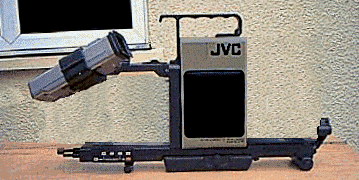 | |
 | |||||||
| |||||||
 |  | ||||||
 | FORMAT: VHS-C | ||||||
DATE: 1983 PRICE: £? [2005: £?] xx cm kg | |||||||
 |  |
|
| |||||||||||||||||||||||||||||||
| The SF-P3 is an unusual exhibit in my little museum, because it doesn't actually record or playback any tapes or disks. In fact it could be considered merely as an accessory for a VHS-C recorder & camera -- but when all three are put together the system becomes something new, something greater than the sum of its parts... |
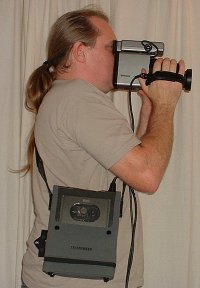 | With a "Traditional" portable video system you slung the recorder over your shoulder, with a cable connecting it to your hand-held camera. But, as VCRs and tapes became smaller, another layout became possible: the same two units can be docked together, to produce a single, shoulder-mounted camcorder. The SF-P3 cradle is the centre of a modular camcorder system using standard VHS-C equipment, which was available from many different manufacturers. (The one pictured is a german Telefunken clone of JVC's HR-C3.) |
| To assemble the system, the VCR slides into the rear and is locked in place by a tripod-like screw. The main controls are still accessible at the rear, and there are cutouts for the RF and AV sockets on the top. An access door under the carrying handle allows the battery to be changed without having to remove the VCR. | 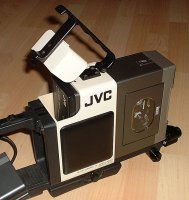 |
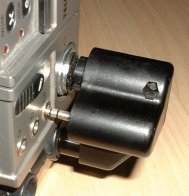 | A neat swinging arm raises up and makes electrical connection between the SF-P3 cradle, and the camera & pause sockets of the recorder. |
| The camera attaches in the same way at the front, and there's a bracket which ensures that it doesn't fall out even if the tripod screw comes undone. A flying lead connects the camera to the cradle, via a socket on the camera's handgrip. | 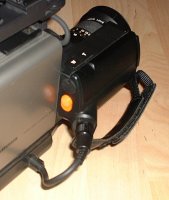 |
 | The camera's viewfinder slips off and clips into the holder, which is fully adjustable. |
| And that's it! You now have a fully integrated system, with a more convenient second set of tape transport controls below the camera, where your left hand would naturally rest. Apart from the size and weight, the system is like any other camcorder. The most puzzling thing for me is, why did they bother to design and manufacture this cradle system, when it would have been no harder to create a single combined unit (with the same insides as the VCR and camera here, but permanently connected in a single case)? Or, create a VCR and camera pair which just clip together, without needing the separate cradle? | 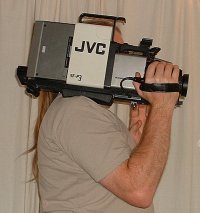 |
| Perhaps it was the influence of similar professional systems -- or perhaps it was flexibility: they assumed that people would like the option of using the VCR and camera in different ways. Whatever, the SF-P3 is a clever device, even if it was obsolete within a year -- when "real" camcorders arrived, as we'll see in the next exhibits. | |